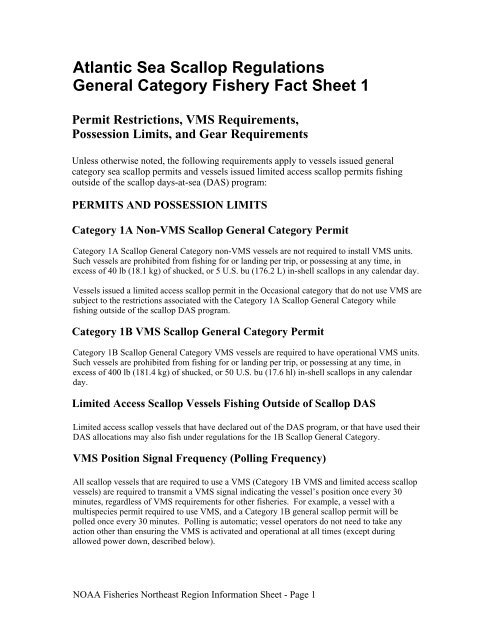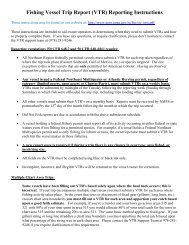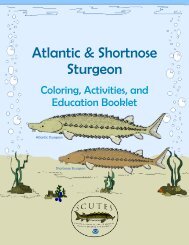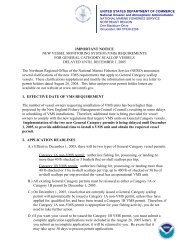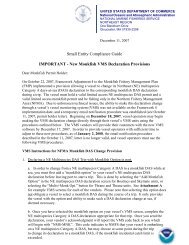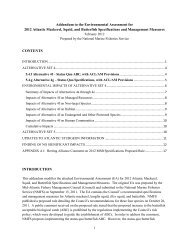Atlantic Sea Scallop Regulations General Category Fishery Fact ...
Atlantic Sea Scallop Regulations General Category Fishery Fact ...
Atlantic Sea Scallop Regulations General Category Fishery Fact ...
Create successful ePaper yourself
Turn your PDF publications into a flip-book with our unique Google optimized e-Paper software.
<strong>Atlantic</strong> <strong>Sea</strong> <strong>Scallop</strong> <strong>Regulations</strong><br />
<strong>General</strong> <strong>Category</strong> <strong>Fishery</strong> <strong>Fact</strong> Sheet 1<br />
Permit Restrictions, VMS Requirements,<br />
Possession Limits, and Gear Requirements<br />
Unless otherwise noted, the following requirements apply to vessels issued general<br />
category sea scallop permits and vessels issued limited access scallop permits fishing<br />
outside of the scallop days-at-sea (DAS) program:<br />
PERMITS AND POSSESSION LIMITS<br />
<strong>Category</strong> 1A Non-VMS <strong>Scallop</strong> <strong>General</strong> <strong>Category</strong> Permit<br />
<strong>Category</strong> 1A <strong>Scallop</strong> <strong>General</strong> <strong>Category</strong> non-VMS vessels are not required to install VMS units.<br />
Such vessels are prohibited from fishing for or landing per trip, or possessing at any time, in<br />
excess of 40 lb (18.1 kg) of shucked, or 5 U.S. bu (176.2 L) in-shell scallops in any calendar day.<br />
Vessels issued a limited access scallop permit in the Occasional category that do not use VMS are<br />
subject to the restrictions associated with the <strong>Category</strong> 1A <strong>Scallop</strong> <strong>General</strong> <strong>Category</strong> while<br />
fishing outside of the scallop DAS program.<br />
<strong>Category</strong> 1B VMS <strong>Scallop</strong> <strong>General</strong> <strong>Category</strong> Permit<br />
<strong>Category</strong> 1B <strong>Scallop</strong> <strong>General</strong> <strong>Category</strong> VMS vessels are required to have operational VMS units.<br />
Such vessels are prohibited from fishing for or landing per trip, or possessing at any time, in<br />
excess of 400 lb (181.4 kg) of shucked, or 50 U.S. bu (17.6 hl) in-shell scallops in any calendar<br />
day.<br />
Limited Access <strong>Scallop</strong> Vessels Fishing Outside of <strong>Scallop</strong> DAS<br />
Limited access scallop vessels that have declared out of the DAS program, or that have used their<br />
DAS allocations may also fish under regulations for the 1B <strong>Scallop</strong> <strong>General</strong> <strong>Category</strong>.<br />
VMS Position Signal Frequency (Polling Frequency)<br />
All scallop vessels that are required to use a VMS (<strong>Category</strong> 1B VMS and limited access scallop<br />
vessels) are required to transmit a VMS signal indicating the vessel’s position once every 30<br />
minutes, regardless of VMS requirements for other fisheries. For example, a vessel with a<br />
multispecies permit required to use VMS, and a <strong>Category</strong> 1B general scallop permit will be<br />
polled once every 30 minutes. Polling is automatic; vessel operators do not need to take any<br />
action other than ensuring the VMS is activated and operational at all times (except during<br />
allowed power down, described below).<br />
NOAA Fisheries Northeast Region Information Sheet - Page 1
VMS Power Down Allowance<br />
Vessels issued a <strong>Category</strong> 1B <strong>General</strong> <strong>Scallop</strong> permit may turn off their VMS unit when they are<br />
tied to a fixed dock or mooring, provided the vessel is not required by any other fishery to keep<br />
the VMS unit on (e.g., Limited Access <strong>Scallop</strong> or NE multispecies). Declaring a Power Down<br />
allows you to turn the power off to your VMS which is beneficial for those vessels that do not<br />
have continuous power available at their mooring. Such vessels must enter the power down<br />
activity code (SES-PWD) upon trying up to the dock or mooring. Any time the vessel leaves the<br />
dock or mooring, for any reason, the VMS unit must be re-powered, and an appropriate activity<br />
code must be entered. The Power Down declaration may only be used by those holding only a<br />
<strong>General</strong> <strong>Category</strong> 1B permit, or those holding a <strong>General</strong> <strong>Category</strong> 1B permit and another<br />
permit(s) that does not require the use of a VMS. The vessel owner/operator must offload the<br />
vessel’s product first and then send a power down declaration on its VMS before being allowed to<br />
turn off the power to the VMS.<br />
NERO strongly recommends you await a confirmation e-mail from your vendor of your power<br />
down activity code before turning the power off to your VMS. The owner/operator prior to<br />
sailing again must have the VMS turned on and operating properly by sending a position signal,<br />
and declaring an activity code before moving the vessel. The ‘DOF” (declare out of fishery)<br />
activity code is appropriate when moving the vessel during times when no fishing activity will<br />
occur or when fishing for species that have no VMS requirement. Otherwise, select and send the<br />
appropriate fishery declaration code.<br />
VMS REQUIREMENTS FOR CATEGORY 1B<br />
1. Make a declaration of your activity on your VMS immediately upon initial installation.<br />
2. You must also make an appropriate declaration prior to moving your vessel. It is in your best<br />
interest to await a confirmation e-mail of your activity code from your vendor before leaving the<br />
dock or mooring. It is also in your best interest to make this declaration each time prior to<br />
moving the vessel, regardless if your activity will be the same activity as your last trip.<br />
3. You can expect to receive an automated e-mail from NERO within 3 hours of your trip start<br />
This automated e-mail will remind you of the VMS activity code you transmitted and direct you<br />
to return inside the VMS demarcation line only if the activity code is incorrect for the trip you<br />
plan to take.<br />
4. You may not change your declared activity code during your return trip to port following a<br />
fishing trip.<br />
<strong>Scallop</strong> Gear Requirements<br />
Gulf of Maine (GOM) and Southern New England (SNE) <strong>Scallop</strong> Dredge<br />
Exemption Areas<br />
(See <strong>General</strong> <strong>Category</strong> <strong>Fact</strong> Sheet 2 for area definitions)<br />
Dredge Restrictions: The combined dredge width for all scallop vessels fishing under the general<br />
category scallop permit in the GOM and SNE scallop dredge exemption area is no more than<br />
10.5 ft (3.2 m), measured at the widest point in the bail.<br />
Minimum Mesh Size: The mesh size of a net, net material or any other material on the top of a<br />
scallop dredge (twine-top) possessed or used by vessels fishing with scallop gear shall not be<br />
NOAA Fisheries Northeast Region Information Sheet - Page 2
smaller than 10-inch (25.4-cm) square or diamond mesh.<br />
Minimum Ring Size: The ring size used in a scallop dredge, possessed or used by scallop vessels<br />
shall not be smaller than 4 inches (10.2-cm).<br />
Link restrictions: No more than double links between rings shall be used in or on all parts of the<br />
dredge bag, except the dredge bottom. No more than triple linking shall be used in or on the<br />
dredge bottom portion and the diamonds. Damaged links that are connected to only one ring, i.e.,<br />
“hangers,” are allowed, unless they occur between two links that both couple the same two rings.<br />
Dredge rings may not be attached via links to more than four adjacent rings. Thus, dredge rings<br />
must be rigged in a configuration such that, when a series of adjacent rings are held horizontally,<br />
the neighboring rings form a pattern of horizontal rows and vertical columns.<br />
Dredge or net obstructions: No material, device, net, dredge, ring, or link configuration or design<br />
shall be used if it results in obstructing the release of scallops that would have passed through a<br />
legal sized and configured net and dredge, as described in this part, that did not have in use any<br />
such material, device, net, dredge, ring link configuration or design. No chafing gear or cookies<br />
shall be used on the top of the dredge<br />
Limited access multispecies vessels fishing under a multispecies DAS and possessing a <strong>Category</strong><br />
1B scallop general category permit and using a trawl sweep no greater then 144 ft (43.9 m) may<br />
catch up to the 400 lb of shucked or 50 bu in-shell scallops. Trawl vessels with trawl sweeps<br />
greater then 144 ft (43.9 m) cannot possess more then 40 lb of shucked or 5 bu in-shell scallops.<br />
Mid-<strong>Atlantic</strong> (MA) Exemption Areas<br />
(See <strong>General</strong> <strong>Category</strong> <strong>Fact</strong> Sheet 2 for area definitions)<br />
Vessels fishing in the MA exemption area are subject to all of the gear restriction stated above<br />
except scallop dredge total width may be up to 31 ft (9.4 m). Further, scallop general category<br />
vessels may use trawl gear to harvest scallops. The sweep of the net cannot exceed 144 ft (43.9<br />
m) unless in possession of less then 40 lb shucked or 5 bu in-shell scallops.<br />
<strong>Scallop</strong> <strong>General</strong> <strong>Category</strong> Control Date<br />
A control date of November 1, 2004 has been established for the scallop general category, and<br />
may be used in the future to establish eligibility criteria for determining levels of future access to<br />
the general category scallop fishery subject to Federal authority.<br />
NOAA Fisheries Northeast Region Information Sheet - Page 3


